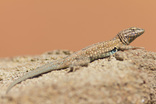This week, the Crew Leaders combined their efforts to survey sites in southeastern Colorado. Unusual July weather in Colorado continued this week, with cool temperatures accompanying the more typical afternoon rain showers. Devin helped manage the increasingly large data set for several days in the office, then ground-truthed some survey routes for the North American Amphibian Monitoring Program as a professional development activity at the end of the week. Danny spent the week working to gain additional public lands access for the project, including properties in Colorado, New Mexico, Kansas, Oklahoma, and Wyoming. He also prepped materials to send out to registered volunteers in the coming week.
*We'll post photos next week, but in the mean-time... from the Field Crew:
| Celina - "Things picked up a little bit more this week which was very exciting for us! It's about the time of year where things are slowing down a bit but we still saw a good variety of species. Sometimes I joke that my favorite method of finding cryptic species is the "I almost stepped on it but then it moved" method because they can be tricky to see. A female Short-horned Lizard did a very good job of escaping my notice until she darted a bit further away as I was stepping quite close to her. Live birth is considered by many to be a "mammal trait" but it's just not true. Short-horned Lizards (and many other cold-adapted species of reptiles such as Prairie Rattlesnakes) give live birth so they can better regulate the temperature of their young as they develop." | Beth - "I had not seen a single reptile under a cow patty all summer. Still, I have been lifting them regularly, my hopes kept alive by stories of skinks and small snakes found squirming underneath them. Torrential rains had left the plains of Comanche National Grassland still soaked in some areas and I was walking through one with a few cow patties in it. I stared down a patty and thought, “this patty will have a snake under it.” I flipped it with my boot and there lay a cream colored Western Ground Snake with a jet-black head on the moist ground! I was shocked that in fact there was actually a snake under this one patty out of at least 40 I had flipped that day alone. It was a species I have never seen before and it showed me its bright pink belly as it twisted into a knot in the grass. As it eventually slinked away, I vowed to flip more cow patties and to be similarly careful about what I wished for." |
 RSS Feed
RSS Feed
